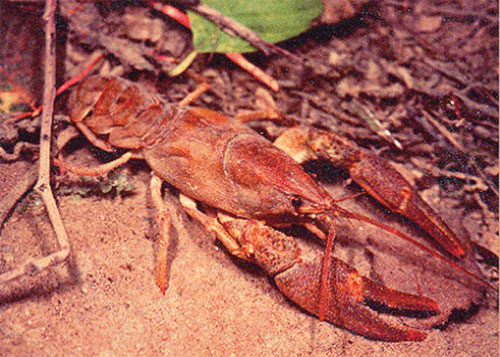Progetto Life - Provincia di Prato
Austropotamobius italicus (Faxon, 1914)
- Common name:WHITE-CLAWED CRAYFISH;
- Phylum :CRUSTACEANS;
- Class: CRUSTACEA;
- Order: DECAPODA;
- Family: Astacidae;
Description and distinctive features:
The White-clawed crayfish is a species of medium-large size (maximum size is approximately 12 cm total length) and varies in colour from to light to dark brown or olive green. The largest of the appendages are the pincers. These have multiple functions: capturing and manipulating prey, defence against predators, reproductive activities (mating and competition with other males), as well as intra and interspecies combat. This species must not be confused with the invasive species, Procambarus clarkii, present in numerous areas of Tuscany and characterized by its large size, lateral red-violet colour and almost black dorsal colour.
Ecological notes:
The White-clawed crayfish is a macro-invertebrate that lives in mountain watercourses (up to a height of 1260 m in southern Switzerland), thanks to its resistance at low temperatures. However, the temperature of the water must not go below 10C, in order to allow normal development of its young. The temperature also has a strong influence on the activity of the species, which is almost completely reduced during the winter. This species is very sensitive to chemical pollution and is therefore considered a good indicator of the healthy conditions of the waters (Gherardi et al., 2001). The greatest requirement of this species, from a chemical point of view, is that of a minimum oxygen concentration of at least 6 ppm (a saturation value of to 60% is optimal) and a quantity of calcium not inferior to 2.8 ppm Calcium is, in fact, a decidedly limiting factor for the Crayfish, as it is necessary for the hardening of the exoskeleton after the shell. The activity of this species is predominantly nocturnal (Barbaresi and Gherardi, 2001). As with other freshwater crustaceans, nocturnal habits are considered an adaptation that allows them escape from predators whose hunting is based on sight, including several species of fish, birds and mammals. The natural shelters of these macro-invertebrates, also from their conspecifics, are the roots of trees near the river banks, vegetal detritus and larger pebbles. Mating take place in autumn and it is possible to find ovigerous females from December to June. Females hold the fertilized eggs (approx. 40-150) under the belly. Larval development is direct and the larvae remain stuck to the female until to the third stage, after which they leave and lead an independent life. Sexual maturity is reached after 2-3 years. The diet of this species, which plays a fundamental role in the food chains of freshwater ecosystems, consists of animal matter, such as the larvae of insects, fish and other dead animals, as well as fresh vegetable matter, like moss, and debris.
Distribution:
The native European crayfish (Austropotamobius genre) is, according to a recent study conducted using molecular biology techniques (Grandjean et al., 2002) and divided into 3 species: A. torrentium (Balkans, Switzerland and Austria), A. pallipes (France, Switzerland, Austria, Great Britain and Ireland) and A. italicus (Spain, Italy, Balkans and Switzerland). In Italy, the White-clawed crayfish is present throughout the country, from Calabria to Piedmont (Froglia, 1978, Laurent, 1988), with the exception of parts of Calabria and Puglia. In northern Italy, it is a commonly found macro-invertebrate in water basins around Venice and Trieste (De Luise, 1988), Liguria (Mori et al., 1988, 1989, Salvidio et al., 1993) and in Tuscany. In particular, A.pallipes is found in north-western regions, while A.italicus is distributed throughout the rest of the peninsula, with four sub-species (Lortscher et al., 1997, Nascetti et al., 1997, Santucci et al., 1997, Grandjean et al., 2000, Largiadèr et al., 2000, Fratini et al., 2004). An area was found in the Ligurian Apennines where the species overlap (Santucci et al., 1997, Nascetti et al., 1997, Fratini et al., 2004). In Tuscany, with the exception of some areas in the Province of Massa, the subspecies A.i.italicus was found (Fratini et al., 2004).
Distribution in the Province of Prato:
A.italicus was found in water courses located in the municipalities of Vernio, Vaiano and Cantagallo.
Conservation status:
In Europe, Austropotamobius pallipes is considered a species at risk (Groombridge, 1996), and at a high risk of extinction in certain areas, such as Spain. In the same way as in other European countries, in Italy both the number and distribution of the populations of this macro-invertebrate have been falling. The anthropic causes of this reduction include (Matthews and Reynolds, 1995) chemical water pollution (acidification, eutrophication and off-flow of toxic substances from agriculture and industry), changes to the physical habitat (caused by the construction of dams, drainage systems, excavations, canalisation and cementification of banks), illegal fishing and the introduction of non-native species originating from North America, such as Procambarus clarkii. In fact, this last species, as well as being a direct and indirect competitor, is also a healthy carrier of "crayfish plague". In some European countries, this disease has wiped out entire populations of native crayfish. From a regulatory point of view, despite the definition of the White-clawed crayfish as a species requiring special conservation areas under Presidential Decree dated 08 September 1997 (no.357), which also indicated it as a species requiring special measures to regulate its use and fishing in nature, Regional Law no.56 dated 06 April 2000 does not list it as a protected species. We believe that this aspect of regional law should be revised in light of the conservation status of the White-clawed crayfish on a European level.
Photos:

centralino: 0574 5341 | info@provincia.prato.it | credits | note legali

